125th anniversary
Alexander Alekhine was born October 31, 1892 — at least according to the Gregorian calendar which is generally used today. But at the time when Alekhine was born, the Julian calendar was widely used in Russia and therefore the date given in Alekhine's birth certificate is October 19, 1892. The more precise Gregorian calendar was only used in Russia after the Russian Revolution. Alekhine's tombstone, however, gives November 1, 1892, as the date of his birth — but this is wrong, as is, ironically, the date of Alekhine's death stated there. Alekhine died on March 24, 1946, in Estoril, Portugal, not on March 25.
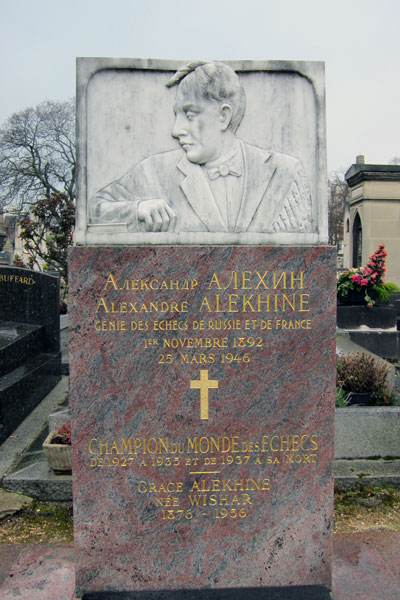 The wrong birthdate is probably due to a conversion mistake between the dates in Julian calendar and the Gregorian calendar. According to a handwritten note Alekhine himself believed that his "Gregorian" birthdate was November 1, 1892: "Je suis né à Moscou le 1er Novembre 1892".
The wrong birthdate is probably due to a conversion mistake between the dates in Julian calendar and the Gregorian calendar. According to a handwritten note Alekhine himself believed that his "Gregorian" birthdate was November 1, 1892: "Je suis né à Moscou le 1er Novembre 1892".
But chess historian Edward Winter did extensive research to establish the correct date of Alekhine's birth.
Alekhine's grave is in Paris, at the Cimetière de Montparnasse (section 8, close to the northern main way), where he is buried together with his third or, perhaps, fourth wife, Grace Wishaar (1876-1956). After his death in 1946 — which itself gave rise to a number of legends and conspiracy theories — the fourth World Champion was buried in Estorial. There were plans to transfer his mortal remains to France later, but these were only realised ten years later, after an initiative by FIDE.
On May 25, 1956, an imposing stone of red granite was erected on his grave, with a portrait of Alekhine in white Carrara marble. There is a chess board on the grave, also made from granite. In 1999 the tombstone broke after a storm, but a couple of years later the stone was restored thanks to the financial support of the Russian entrepreneur Andrey Filatov, who today is President of the Russian Chess Federation.
Opening
Alekhine's mother Anna Alexandrovna Alekhine, née Prokhorov, was the daughter of a wealthy industrialist, and Alekhine's father was an officer in the Russian army. In 1895, his father left the army and worked for the government in a number of organisations until, in 1912, he became a member of the Duma, the Russian parliament. Alexander Alekhine was the third child of the couple. Their oldest son was Alexei Alekhine, born in 1888. Their daughter Varvara was born in 1889.
Alexander Alekhine learned to play chess at the age of seven, taught by his mother. His brother Alexei also played but because both were too young to join a chess club they mainly played correspondence chess. At first, from 1902 to 1904, Alexander Alekhine helped his brother with his analyses, later, from 1905 to 1907, Alexander played correspondence tournaments on his own.
Alekhine's parents sent their son to one of the best and most expensive grammar schools in Moscow. Alexander Alekhine was more interested in the fine arts than in mathematics and already played a lot of chess in his school years.
![Alexander Alekhine in 1909, Karl Bulla [Public domain], via Wikimedia Commons](/portals/all/2017/10/aljechin/Aliochin_A_A__1909_Karl_Bulla.jpg)
In 1907 he joined the chess club of Moscow and in the same year, at the age of 14, he played his first chess tournament. The following year, Alekhine played his first international tournament abroad, the main tournament in Düsseldorf, from August 3rd to August 16th, 1908. He started with 5.0/5 and finished fourth in the end. In 1909, at the age of 16, he played in the All-Russian Amateur Tournament (February 15th, to March 3rd), and won the title and an expensive vase that was worth 650 rubles. On top of that he earned the right to call himself "Master".
In 1910 (July 18th, to August 6th) Alekhine himself played in a strong international tournament, the 17. Congress of the German Chess Federation in Hamburg. Alekhine finished in the middle of the 17-player strong field, but at least half a point ahead of Siegbert Tarrasch. Carl Schlechter won ahead of Oldrich Duras.
The Wiener Schachzeitung wrote:
"The young student from Moscow is without a doubt gifted with a considerable chess talent which already shows in his amazing skills. … His traps and finesses are exquisite to which his games against Teichmann, John and Tartakower testify. He probably would have fared even better if he had not fallen victim to a temporary physical indisposition, which he incidentally bravely controlled which brought him sympathies from all sides." (Wiener Schachzeitung 1910, p. 348-349)
Alekhine suffered from a bad infection and every day he had to be carried to the tournament.
After finishing school Alekhine started to study law in 1911 and the same year he took part in the big tournament in Karlsbad. Richard Teichmann played the tournament of his life and won. In the end Alekhine shared 8th to 11th place in a field of 26 players.
P.S. Leonhardt wrote in the Hamburger Nachrichten:
"Alekhine, a young Russian aristocrat, ambitious and full of talent, has what it takes to become a great player but he first has to try to get his nervous disposition under control."
The following year the "Russian aristocrat" won his first major tournament in Stockholm where he finished first ahead of Cohn, Marco and Spielmann. In 1913 Alekhine won in Scheveningen ahead of Janowski, Olland and Yates. 1914 was an important year for Alekhine's career because he qualified for the prestigious international Master Tournament in St. Petersburg.
This tournament was played in two stages, the first was a preliminary tournament, in which the five best players qualified for the final — a double round-robin tournament. With a shared fourth place in the preliminary tournament Alekhine qualified for the final where he came third. The preliminary tournament was won by Capablanca, and the final tournament was won by Lasker. In this tournament Alekhine joined the very best of the world. Only players who could boast of winning a major tournament and who had distinguished themselves as "Grandmasters of Chess" (an unofficial title) had been invited to St. Petersburg. During the tournament, Alekhine established a friendship with Capablanca and invited him to his house and analysed games with him. This friendship later turned to enmity.
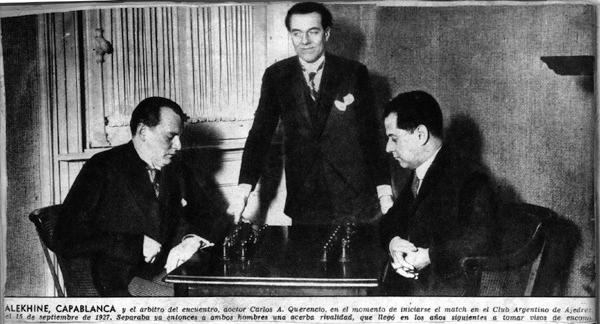
Left to right: Alexander Alekhine, arbiter Dr. Carlos Augusto Querencio and José Raúl Capablanca during World Chess Championship in Buenos Aires, 1927
Middlegame
In 1914, Alekhine and a number of other Russian players took part in the 19th Congress of the German Chess Union in Mannheim. World War I broke out and Alekhine and the other Russians were interned in various cities. Alekhine spent the longest time of his internment in Rastatt, where he shared a cell with Efim Boguljubow. Of course the two spent most of their time playing chess.
The German doctors finally declared Alekhine unfit for military service and September 14, 1914, he, Bohatyrchuk, Saburov and Koppelman were released and sent to Switzerland. In Basel he met his parents who had come to Germany to spend time in a health spa in Wiesbaden and had also been temporarily interned after the outbreak of the war. The following year Alekhine's mother died in Basel and Alekhine and his father waited until 1916 before returning to Moscow. Alekhine's father still worked for some time for governmental organisations and died after a long illness on May 28, 1917.
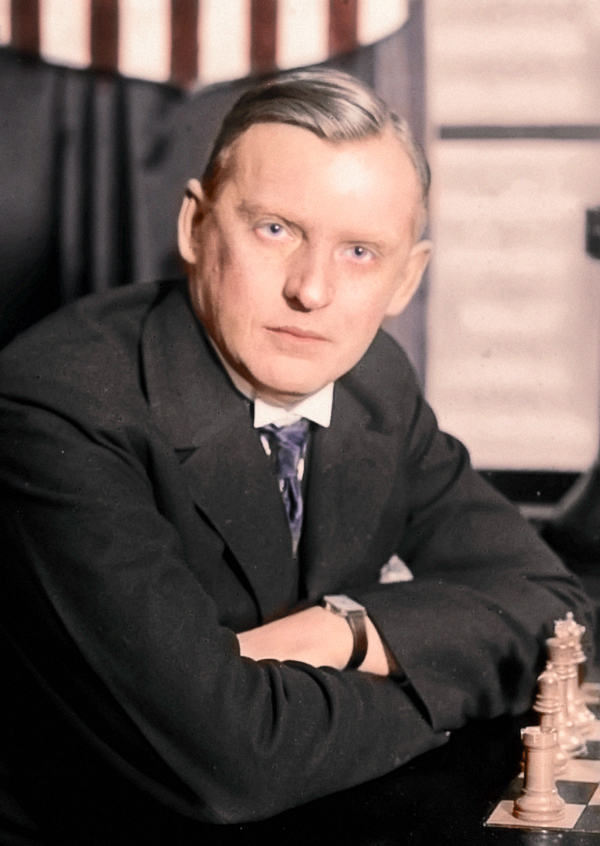
After his return to Russia Alekhine served in the Red Cross and was severely wounded at the Galician frontline. He spent some time in the monastic hospital of Tarnopol and played a number of games against local masters, some of which were passed on.
The war and the Russian Revolution were a turninng point in the life of Alexander Alekhine. After the death of his parents he also lost his material possessions in the course of the Russian Revolution. Allegedly, in 1919 Alekhine had to face a firing squad in Odessa because he was a member of the aristocracy or because he was suspected to be a spy but was saved by an intervention from the very top. The most dramatic version of this story claims that Alekhine had to play chess for his life against Leo Trotzki and won this most crucial game.
Like so many others, Alekhine had to struggle along in the chaos following Russian Revolution. As a chess player this was not possible. He took acting lessons, worked for the police and as a translator for the Comintern. Here he met the well-known Swiss communist and journalist Annaliese Rüegg whom he married on March 15, 1921.
Alekhine had already married in 1920, with the widower Anna of Sewergin, to legalise the birth of their daughter, Valentina (December 15th, 1913). But this marriage did not last long and ended the same year. Because Anneliese Rüegg had excellent connections to the bolshevist leaders she and her husband were allowed to leave Russia. The couple first went to Berlin but Alekhine continued his travels and played tournaments in Budapest and The Hague. When he returned to Berlin his wife had gone to Switzerland where she gave birth to a son, Alexander Alekhine Jr., on November 2, 1921.
Alekhine settled in France where he lived from 1921 onwards. In 1926, Rüegg and Alekhine divorced — apparently the marriage between the two had never been officially acknowledged in Switzerland.
Title shot
After leaving the Soviet Union, Alekhine began his rise to the chess throne. In 1921 he challenged Capablanca for the first time to a title match, and he was not the only player to do so. In 1922, at the tournament in London, Capablanca had invited the masters who were present to a glass of wine and told them his conditions for a title match. In his book Goldene Schachzeiten (The Golden Times of Chess) Milan Vidmar described this episode:
"The challenger of the World Champion had to raise 10,000 (ten thousand) dollars, and he had to take care for travelling costs and accomodation of the two players. A further clause of the statute provided that the winner would have to receive 6,000 (six thousand) dollars, while the loser would receive 4,000 (four thousand) dollars."
These demands were a big hurdle for all grandmasters who wanted to challenge the reigning World Champion and thus it took five years until one of them — Alekhine — was able to raise this sum with the help of sponsors.
Alekhine was the underdog in his match against Capablanca that began September 17, 1927 in Buenos Aires, and ended November 28, 1927, making it the longest World Championship match in the history of chess for nearly sixty years until the match between Karpov and Kasparov 1984/1985. Despite being the underdog Alekhine won the very first game which came as quite a shock to Capablanca who hitherto had not lost a single game against Alekhine.
This French Defence DVD is a complete attacking opening repertoire for black after 1.e4 e6. GM Nick Pert has played the French defence his whole life and provides all his la test and most up to date analysis crammed into 1 DVD.
The Cuban equalised the score in game three and took the lead after game seven, but after losses in games eleven and twelve he was trailing again. There followed a series of eight draws until in Game 21 Alekhine scored another win. Game 29 was won by Capablanca, but with wins in Game 32 and Game 34 Alekhine won the match and became new World Champion. (The match was won by the player who first won six games.)
The circumstances of the match turned the former friends into bitter enemies. Alekhine felt snubbed by Capablanca's behaviour and by Capablanca's demands. After the match Alekhine and Capablanca were no longer on speaking terms and avoided each other. Of course, Capablanca tried to arrange a rematch but in vain. Alekhine took care that the hurdle for Capablanca was as high as it had been for him when Capablanca was still World Champion.
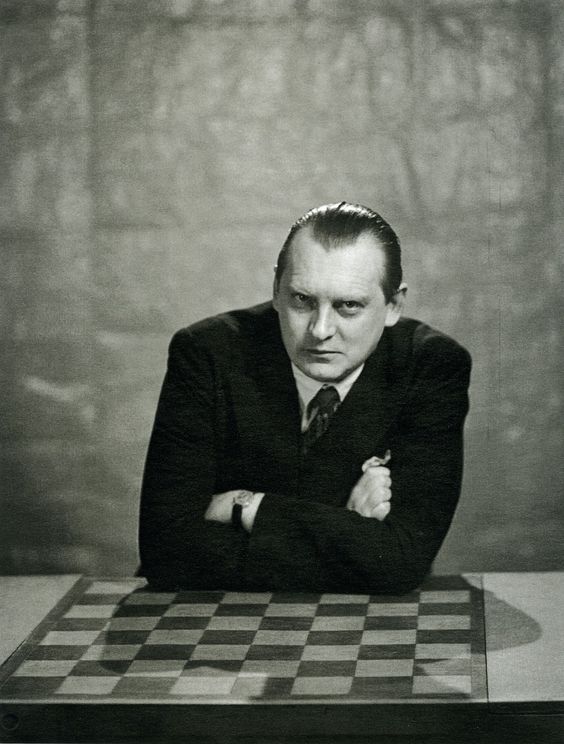
Alexander Alekine portrait by Man Ray
Title defence
Alekhine was much more forthcoming towards his other challengers, Bogoljubow and Euwe. Alekhine defended his title twice (in 1929 and in 1934) against Boguljubow who after World War I had stayed in Germany. In both cases Boguljubow had organised the match.
In 1935 Alekhine played against Max Euwe and lost the title. Alekhine was in bad physical shape not least because of his excessive drinking. But this should not diminish Euwe's performance. In a revenge match which Euwe was ready to grant, Alekhine regained the title in 1937.
In 1939 Alekhine and many other chessplayers were surprised by the outbreak of World War II during the Chess Olympiad 1939 in Buenos Aires. A lot of players stayed in South America, Alekhine returned to his wife Grace Wishaar and joined the French Army in its fight against Hitler's Germany. Because of his language skills — Alekhine is said to have spoken ten languages — he worked on intelligence matters.
After the capitulation of the French he first went to the zone occupied by the Vichy regime but later collaborated with the German occupying forces. Alekhine's wife Grace Wishaar was Jewish and maybe Alekhine saw no alternative. After the war he justified his collaboration by claiming that otherwise he and his wife would have been sent to a concentration camp.
In 1941 Alekhine published his infamous tract about "Jewish and Aryan chess". He took part in tournaments and chess events which Hans Frank, the Governor General of occupied Poland who was a chess fan, organised at his castle in Krakow. Alekhine also gladly accepted invitations to play in Spain and Portugal because he hoped to find a way to emigrate to America. But in vain.
Endgame
At the end of World War II Alekhine was in Estoril, poor, chronically ill, and marked by years of alcoholic abuse. Before the war Botvinnik had started negotiations with Alekhine about a possible World Championship match. Now Botvinnik took up the thread again. Botvinnik wrote two letters to Alekhine, and Alekhine hoped that the match against Botvinnik would come about because he hoped for a considerable sum. But on March 24 Alekhine was found dead in his hotel room.
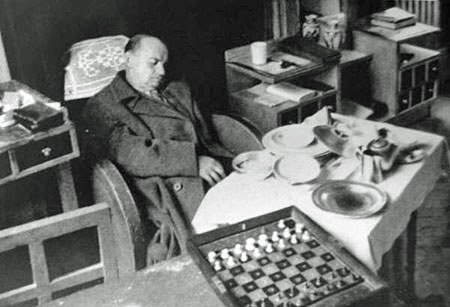
The circumstances of his death are mysterious and some crudities gave rise to numerous conspiracy theories. There are two very similar photos of the dead World Champion in which the scene appears to be arranged. According to the medical report Alekhine choked on a piece of meat he ate during his dinner.
The photos show a lot of plates but no food. This would mean that he literally choked on his last piece of food. Boris Spassky believed that the French Resistance killed Alekhine because he had collaborated with the Germans. Others claimed that the KGB, the Soviet Secret Service, had pulled the strings. Botvinnik had enemies within the KGB and maybe someone wanted to prevent a match between Botvinnik and Alekhine.
In any case, a tragic end to an interesting and storied life.
Correction November 2: Capablanca won games 29, 32 and 34, not games 28, 31 and 33 as originally stated in the article. The Cuban was White in the odd-numbered games.
Translation from German: Johannes Fischer
On this DVD GMs Rogozenco, Marin, Müller, and IM Reeh present outstanding games, stunning combinations and exemplary endgames by Alekhine. And they invite you to improve your knowledge with the help of video lectures, annotated games and interactive tests
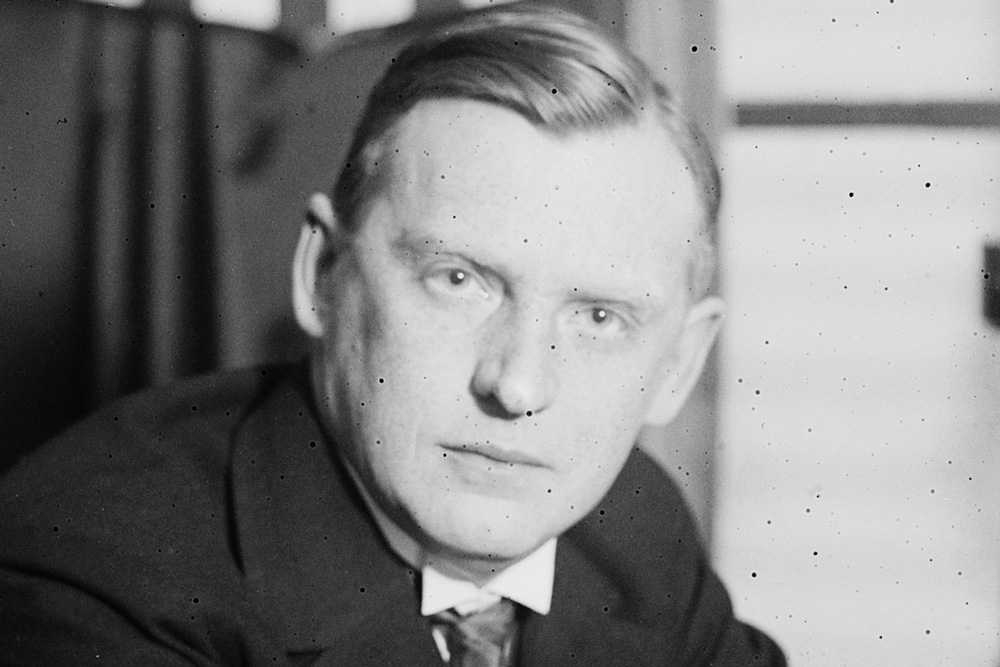

















 The wrong birthdate is probably due to a conversion mistake between the dates in Julian calendar and the Gregorian calendar. According to a handwritten note Alekhine himself believed that his "Gregorian" birthdate was November 1, 1892: "Je suis né à Moscou
The wrong birthdate is probably due to a conversion mistake between the dates in Julian calendar and the Gregorian calendar. According to a handwritten note Alekhine himself believed that his "Gregorian" birthdate was November 1, 1892: "Je suis né à Moscou ![Alexander Alekhine in 1909, Karl Bulla [Public domain], via Wikimedia Commons](/portals/all/2017/10/aljechin/Aliochin_A_A__1909_Karl_Bulla.jpg)









